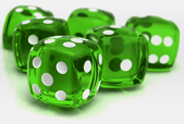Single vs Multiple Deck Blackjack
The one major factor that changes your blackjack strategy is the number of decks your favorite casino or card room uses. When the game of blackjack first began to gain popularity, most casinos only used one deck of cards. Unfortunately, crafty players began counting cards and the casinos grew terrified of losing their advantage. Thus, many casinos began using multiple decks to prevent counting. Since the introduction of multiple-deck blackjack, players have been searching for ways to decrease the ever-increasing house advantage.
Playing with one deck allows players a greater advantage than the multi-deck game because your actions are based in large part on knowing the odds of the dealer making his hand or going bust. For example, single deck strategy always takes into account two factors, namely, your cards and the dealer’s upcard, to guide you on what actions to take. One thing is you can easily keep track of the cards that are played. There are only 4 Aces and 16 tens in one deck of cards, and you can easily figure out the dealer’s chances of busting or not.
Playing with a multiple deck gets more complicated because there are more factors to consider. Following these basic guidelines should help you greatly when you encounter multiple decks. If you have a hard 17 through 21, you should always stay. Because the dealer has to draw until he has 17, the extra decks increase the possibility of a bust. In addition to this rule, other basic strategies for multiple-deck Blackjack are as follows:
- If your hand totals 13 through 16, and the dealer’s upcard is 6 or lower you should stay. If the dealer’s up card is 7 or higher, hit.
- If your hand is 12 and the dealer’s upcard is 4-6, you should stay, but you have to hit if upcard is 2, 3, or 7.
- If your cards total 11 and the dealer’s up card is anything other than an Ace, double down. If the upcard is an Ace, hit.
- Always hit if your card total is 8 or less
- If your cards total 10 and the dealer’s upcard is anything other than an Ace, 10, or face card, double down. If the upcard is Ace or 10-value card,
hit.
The multiple-deck game gets even more difficult when you factor in soft totals, pairs, and splitting hands. Some similarities shared between both strategies include, always split pairs of Aces and 8’s, and never split 10’s. Splitting Aces and 8’s gives you a chance to double your money and a pair of 10’s gives you a great chance to win. Consult the multiple-deck strategy chart below for a better understanding of how the game should be played.
- H= Hit
- S= Stand
- D = Double down D
- P = split Pairs
|
Dealer –> |
2 |
3 |
4 |
5 |
6 |
7 |
8 |
9 |
10 |
11 |
|
Player (down) |
||||||||||
|
9 |
H |
D |
D |
D |
D |
H |
H |
H |
H |
H |
|
10 |
D |
D |
D |
D |
D |
D |
D |
D |
H |
H |
|
11 |
D |
D |
D |
D |
D |
D |
D |
D |
D |
H |
|
12 |
H |
H |
S |
S |
S |
H |
H |
H |
H |
H |
|
13 – 16 |
S |
S |
S |
S |
S |
H |
H |
H |
H |
H |
|
A + 2; 3 |
H |
H |
H |
D |
D |
H |
H |
H |
H |
H |
|
A + 4; 5 |
H |
H |
D |
D |
D |
H |
H |
H |
H |
H |
|
A + 6 |
H |
D |
D |
D |
D |
H |
H |
H |
H |
H |
|
A + 7 |
S |
D |
D |
D |
D |
S |
S |
H |
H |
H |
|
2 + 2 |
P |
P |
P |
P |
P |
P |
H |
H |
H |
H |
|
3 + 3 |
P |
P |
P |
P |
P |
P |
H |
H |
H |
H |
|
4 + 4 |
H |
H |
H |
P |
P |
H |
H |
H |
H |
H |
|
6 + 6 |
P |
P |
P |
P |
P |
H |
H |
H |
H |
H |
|
7 + 7 |
P |
P |
P |
P |
P |
P |
H |
H |
H |
H |
|
9 + 9 |
P |
P |
P |
P |
P |
S |
P |
P |
S |
S |

